This summer, visitors to Magers Health and Wellness Center on the Missouri State University Campus will enjoy an exhibition of Associate Professor Kevin Hughes’ work in clay. Six platters using wide ranging glaze and firing techniques will be on display in the Taylor Gallery space on the second floor. Visitors are greeted with informational labels the artist provided that describe the processes used with each platter. These works will be on display through the end of August 2018.
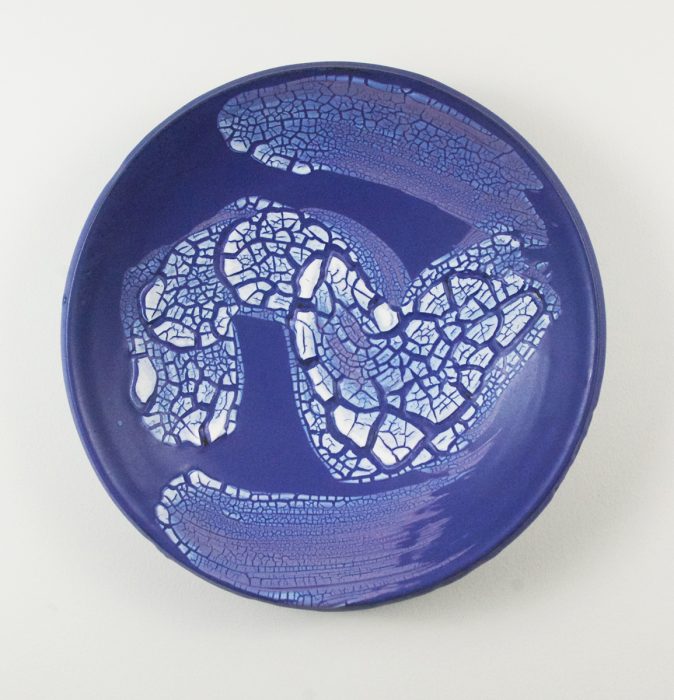
Crackle Lines, 2018
3”h x 14”w x14”d
Wheel-thrown dark stoneware platter with application of textural slip in the shape of a spiral. This piece was fired in a gas reduction kiln to a temperature of Cone 10, 2,350 degrees Fahrenheit. A reduction firing is a type of firing that requires a fuel rich, oxygen deprived atmosphere during certain times of the firing to produce the correct colors on the vessels. The same glaze fired in an oxygen rich atmosphere, an “oxidation firing,” will look different.
This piece is glazed with two glazes. The base glaze is an opaque purple matte glaze. The white glaze on top is technically not a glaze but more of a slip that has a high percentage of magnesium carbonate in it. During the firing the magnesium carbonate will shrink and crack, creating a texture similar to a creek bed, high in clay content that has dried out and cracked.
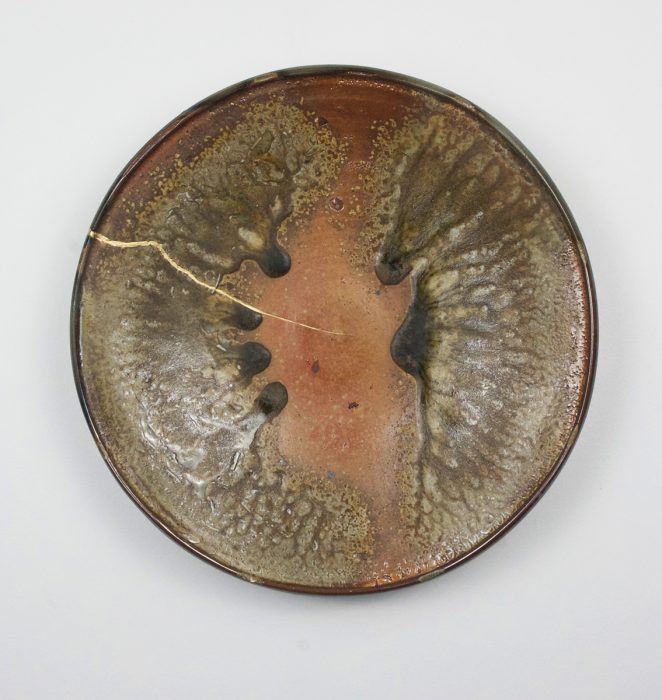
Gold Strike, 2018
2”h x 14”w x 14”d
Wheel-thrown dark stoneware platter, fired for 60 hours in an anagama kiln that was fueled with wood to a temperature of approximately 2,400 degrees Fahrenheit. An anagama is an ancient “tube” type kiln associated with Japan yet originated in China over 5,000 years ago. The early kilns were literal tunnels dug into the hillside following the contour of the hill. A fire would be built at the low end or entrance to the “tube”; the heat, flame, and ash would rise through the narrowing chamber that held clay vessels and exit through a smaller hole further up the hill. As the ash passed through the kiln, it would land on the clay ware inside and accumulate. When the temperature in the kiln reached over 2,000 degrees Fahrenheit, the ash would melt and form a natural glaze on the vessels. A green color in the natural glaze signifies that hard woods were used to fuel the kiln, and a yellow color glaze is a result of soft woods used to fuel the kiln.
Gold Strike cracked in the firing due to “thermal shock,” where the clay body was heated unevenly resulting in different expansion rates and, thus, the crack. It was repaired imitating an ancient Japanese method known as “kintsugi.” Kintsugi uses a natural resin that is used to repair the broken ware. While the resin is still wet, it is dusted with gold resulting in a golden line. In Japan, ceramics that have Kintsugi incorporated into the piece are considered to be of more value than other wares since the repair indicates that the piece has been used, sometimes for generations, was broken, and then mended so that more generations can enjoy using the form. Today, some contemporary Japanese potters will break the best wares that come out of their kilns, repair them with kintsugi, and then sell the vessels for more money.
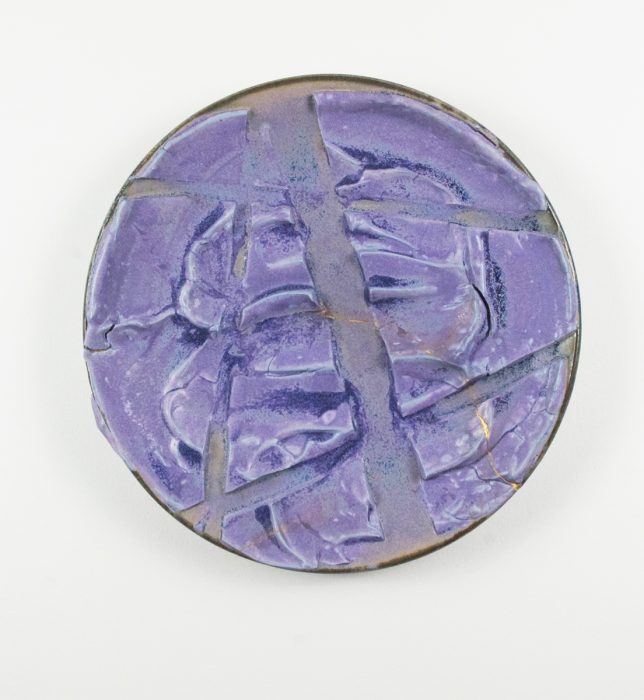
Negative Space Line Study in Violet, 2018
2”h x 13”w x 13d
Wheel-thrown dark stoneware platter altered with an application of porcelain slip. This piece was fired in a gas reduction kiln to a temperature of Cone 10, 2,350 degrees Fahrenheit. A reduction firing is a type of firing that requires a fuel rich, oxygen deprived atmosphere during certain times of the firing to produce the correct colors on the vessels. The same glaze fired in an oxygen rich atmosphere, an “oxidation firing,” will look different.
After the piece was thrown, lines were laid out using blue painter’s tape of varying widths. The platter was then covered in a thick, smooth porcelain slip. After the slip had dried, some the tape was removed to create the negative space lines in the composition. The glaze is a violet matte that is considered to be mottled. The varieties of colors that you see come from one glaze and are created due to the color of the underlying clay body, light or dark, and the thickness of the glaze application.
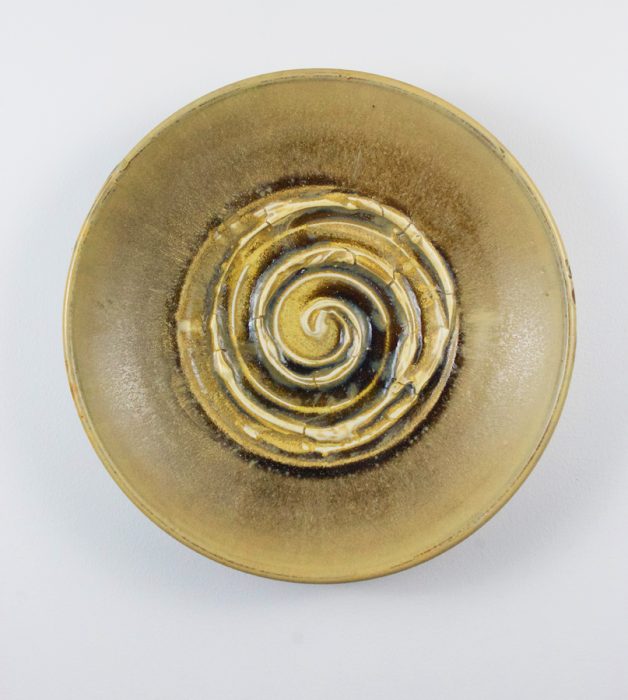
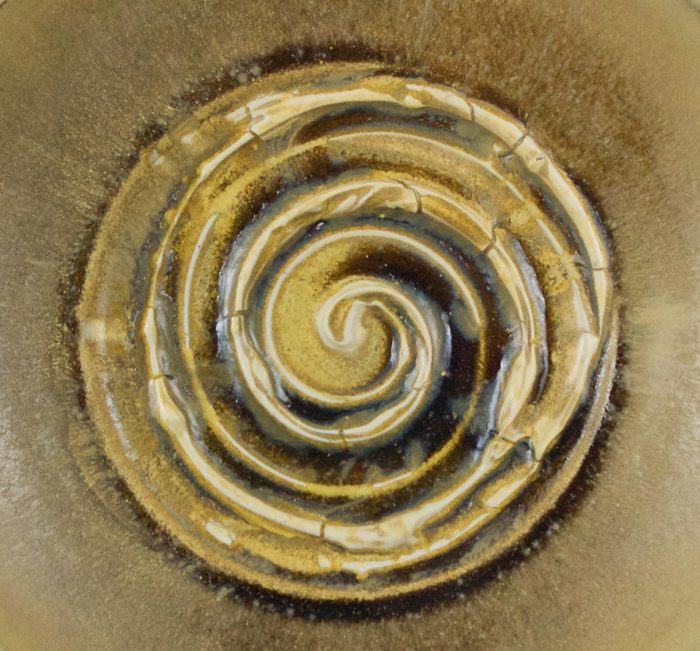
Primordial Spiral in Tan, 2018
2”h x 13”w x 13”d
Wheel-thrown dark stoneware platter altered with an application of porcelain slip. This piece was fired in a gas reduction kiln to a temperature of Cone 10, 2,350 degrees Fahrenheit. A reduction firing is a type of firing that requires a fuel rich, oxygen deprived atmosphere during certain times of the firing to produce the correct colors on the vessels. The same glaze fired in an oxygen rich atmosphere, an “oxidation firing,” will look different.
After the piece was thrown, the center of the platter was then covered in a thick, smooth porcelain slip. Using the rotation of the potter’s wheel, a spiral was laid into the slip. The glaze is a matte tan that is considered to be mottled. The varieties of colors that you see come from one glaze and are created due to the color of the underlying clay body, light or dark, and the thickness of the glaze application.
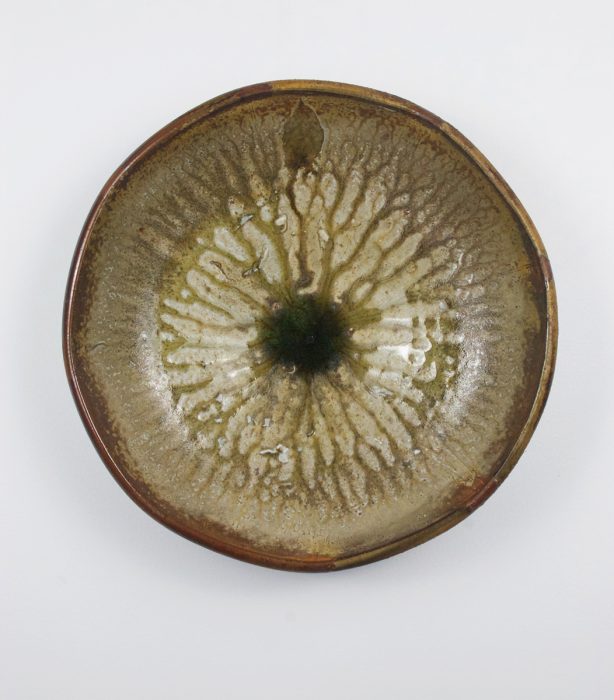
Rivulets and Green Pool of Contemplation, 2018
3.5”h x 14”w x 14”d
Wheel-thrown dark stoneware platter, fired for 60 hours in an anagama kiln that was fueled with wood to a temperature of approximately 2,400 degrees Fahrenheit. An anagama is an ancient “tube” type kiln associated with Japan yet originated in China over 5,000 years ago. The early kilns were literal tunnels dug into the hillside following the contour of the hill. A fire would be built at the low end or entrance to the “tube”; the heat, flame, and ash would rise through the narrowing chamber that held clay vessels and exit through a smaller hole further up the hill. As the ash passed through the kiln, it would land on the clay ware inside and accumulate. When the temperature in the kiln reached over 2,000 degrees Fahrenheit, the ash would melt and form a natural glaze on the vessels. A green color in the natural glaze signifies that hard woods were used to fuel the kiln, and a yellow color glaze is a result of soft woods used to fuel the kiln.
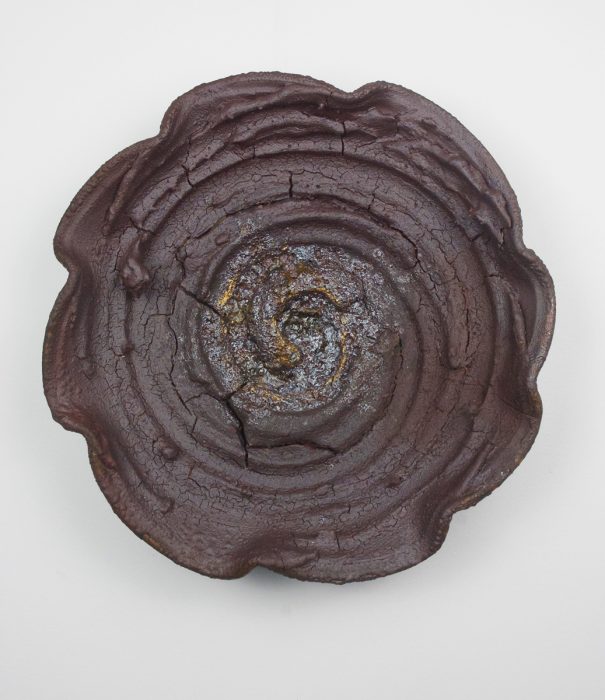
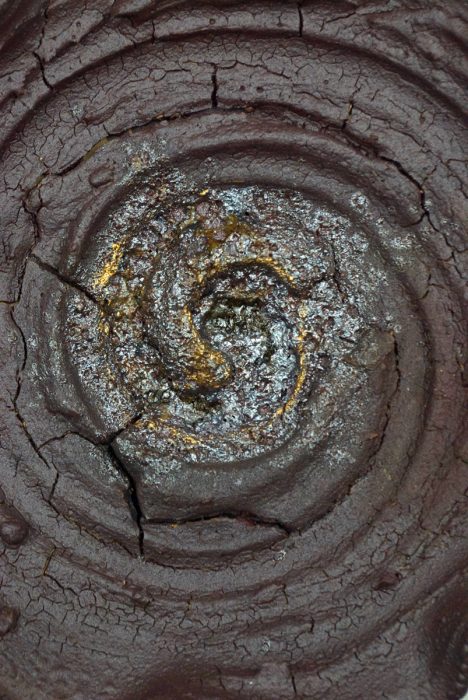
Volcanic Creations, 2018
4”h x 16”w x 16”d
Wheel-thrown and altered dark stoneware platter with application of textural porcelain slip in the shape of a spiral. This piece was fired in a gas reduction kiln to a temperature of Cone 10, 2,350 degrees Fahrenheit. A reduction firing is a type of firing that requires a fuel rich, oxygen deprived atmosphere during certain times of the firing to produce the correct colors on the vessels. The same glaze fired in an oxygen rich atmosphere, an “oxidation firing,” will look different.
After the platter was thrown and alter around its lip, a thick porcelain slip was added to the form and a “spiral” shape was created using the rotation of the potter’s wheel. The form was glaze fired with a red “crater glaze” on its surface. The glaze resulted in some of the cracks and textures that you see on the surface. In the middle of the spiral on top of the glaze, a melting “accelerator” was applied, which resulted in the silvery pumice part of the glazed surface.
